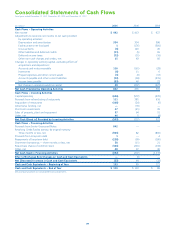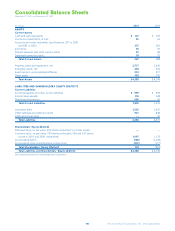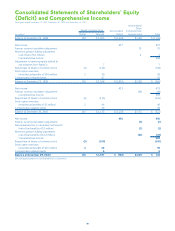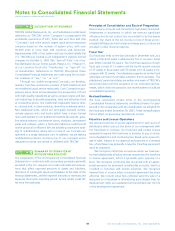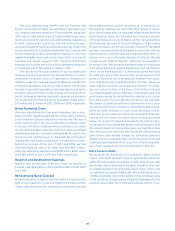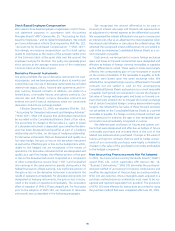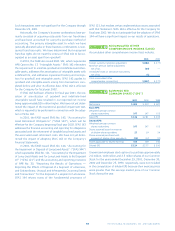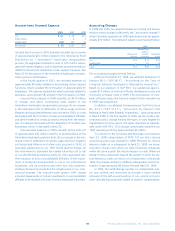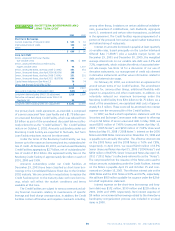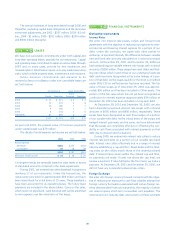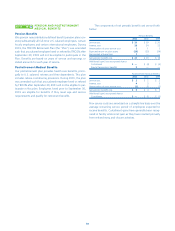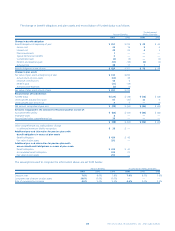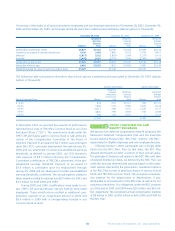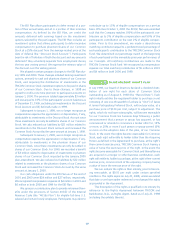Pizza Hut 2001 Annual Report Download - page 50
Download and view the complete annual report
Please find page 50 of the 2001 Pizza Hut annual report below. You can navigate through the pages in the report by either clicking on the pages listed below, or by using the keyword search tool below to find specific information within the annual report.
48 TRICON GLOBAL RESTAURANTS, INC. AND SUBSIDIARIES
Unusual Items (Income) Expense
2001 2000 1999
U.S. $15 $29 $13
International —83
Unallocated (18) 167 35
Worldwide $ (3) $204 $51
Unusual items income in 2001 primarily included: (a) recoveries
of approximately $21 million related to the AmeriServe Food
Distribution Inc. (“AmeriServe”) bankruptcy reorganization
process; (b) aggregate settlement costs of $15 million associ-
ated with certain litigation; and (c) expenses, primarily severance,
related to decisions to streamline certain support functions. See
Note 22 for discussions of the AmeriServe bankruptcy reorgan-
ization process and litigation.
In the fourth quarter of 2001, we recorded expenses of
approximately $4 million related to streamlining certain support
functions, which included the termination of approximately 90
employees. The reserves established, which primarily related to
severance, were almost fully utilized in the first quarter of 2002.
Unusual items expense in 2000 included: (a) $170 million
of charges and direct incremental costs related to the
AmeriServe bankruptcy reorganization process; (b) an increase
in the estimated costs of settlement of certain wage and hour
litigation and associated defense costs incurred in 2000; (c) costs
associated with the formation of new unconsolidated affiliates;
and (d) the reversal of excess provisions arising from the resolu-
tion of a dispute associated with the disposition of our Non-core
Businesses, which is discussed in Note 22.
Unusual items expense in 1999 included: (a) the write-off
of approximately $41 million owed to us by AmeriServe at the
AmeriServe bankruptcy petition date; (b) an increase in the esti-
mated costs of settlement of certain wage and hour litigation
and associated defense and other costs incurred in 1999; (c)
favorable adjustments to our 1997 fourth quarter charge; (d)
the write-down to estimated fair market value less cost to sell
of our idle Wichita processing facility; (e) costs associated with
the formation of new unconsolidated affiliates; (f) the impair-
ment of enterprise-level goodwill in one of our international
businesses; and (g) severance and other exit costs related to
strategic decisions to streamline the infrastructure of our inter-
national business. The original fourth quarter 1997 charge
included impairments of certain investments in unconsolidated
affiliates to be retained and costs of certain personnel reductions.
Accounting Changes
In 1998 and 1999, we adopted several accounting and human
resource policy changes (collectively, the “accounting changes”)
which favorably impacted our 1999 operating results by approx-
imately $29 million. The estimated impact is summarized below:
1999
General and
Admini-
Restaurant strative Operating
Margin Expenses Profit
U.S. $11 $ 4 $ 15
Unallocated — 14 14
Total $11 $18 $ 29
The accounting changes were as follows:
Effective December 27, 1998, we adopted Statement of
Position 98-1 (“SOP 98-1”), “Accounting for the Costs of
Computer Software Developed or Obtained for Internal Use.”
Based on our adoption of SOP 98-1, we capitalized approxi-
mately $13 million of internal software development costs and
third party software costs in 1999. The amortization of com-
puter software assets that became ready for their intended use
in 1999 was insignificant.
In addition, we adopted Emerging Issues Task Force Issue
No. 97-11 (“EITF 97-11”), “Accounting for Internal Costs
Relating to Real Estate Property Acquisitions,” upon its issuance
in March 1998. In the first quarter of 1999, we also made a dis-
cretionary policy change limiting the types of costs eligible for
capitalization to those direct cost types described as capitaliz-
able under SOP 98-1. This change unfavorably impacted our
1999 operating profit by approximately $3 million.
To conform to the Securities and Exchange Commission’s
April 23, 1998 interpretation of SFAS 121 our store closure
accounting policy was changed in 1998. Effective for closure
decisions made on or subsequent to April 23, 1998, we recog-
nize store closure costs when we have closed the restaurant
within the same quarter the closure decision is made. When we
decide to close a restaurant beyond the quarter in which the clo-
sure decision is made, we review it for impairment. In fiscal year
1999, this change resulted in additional depreciation and amor-
tization of approximately $3 million through April 23, 1999.
In 1999, the methodology used by our independent actu-
ary was refined and enhanced to provide a more reliable
estimate of the self-insured portion of our current and prior
years’ ultimate loss projections related to workers’ compensation,



